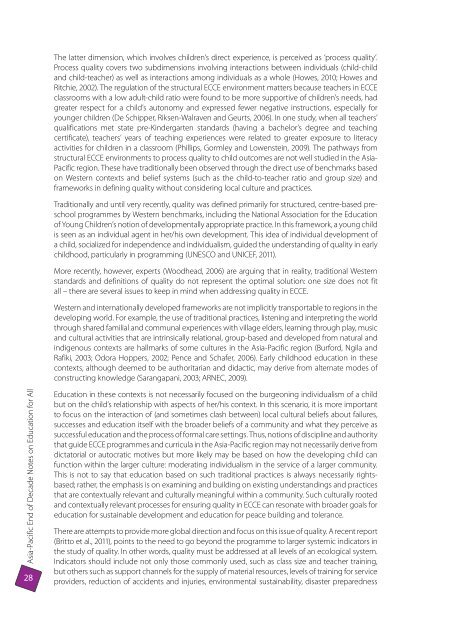EFA Goal 1: Early childhood care and education; Asia ... - Unicef
EFA Goal 1: Early childhood care and education; Asia ... - Unicef
EFA Goal 1: Early childhood care and education; Asia ... - Unicef
You also want an ePaper? Increase the reach of your titles
YUMPU automatically turns print PDFs into web optimized ePapers that Google loves.
The latter dimension, which involves children’s direct experience, is perceived as ‘process quality’.<br />
Process quality covers two subdimensions involving interactions between individuals (child-child<br />
<strong>and</strong> child-teacher) as well as interactions among individuals as a whole (Howes, 2010; Howes <strong>and</strong><br />
Ritchie, 2002). The regulation of the structural ECCE environment matters because teachers in ECCE<br />
classrooms with a low adult-child ratio were found to be more supportive of children’s needs, had<br />
greater respect for a child’s autonomy <strong>and</strong> expressed fewer negative instructions, especially for<br />
younger children (De Schipper, Riksen-Walraven <strong>and</strong> Geurts, 2006). In one study, when all teachers’<br />
qualifications met state pre-Kindergarten st<strong>and</strong>ards (having a bachelor’s degree <strong>and</strong> teaching<br />
certificate), teachers’ years of teaching experiences were related to greater exposure to literacy<br />
activities for children in a classroom (Phillips, Gormley <strong>and</strong> Lowenstein, 2009). The pathways from<br />
structural ECCE environments to process quality to child outcomes are not well studied in the <strong>Asia</strong>-<br />
Pacific region. These have traditionally been observed through the direct use of benchmarks based<br />
on Western contexts <strong>and</strong> belief systems (such as the child-to-teacher ratio <strong>and</strong> group size) <strong>and</strong><br />
frameworks in defining quality without considering local culture <strong>and</strong> practices.<br />
Traditionally <strong>and</strong> until very recently, quality was defined primarily for structured, centre-based preschool<br />
programmes by Western benchmarks, including the National Association for the Education<br />
of Young Children’s notion of developmentally appropriate practice. In this framework, a young child<br />
is seen as an individual agent in her/his own development. This idea of individual development of<br />
a child, socialized for independence <strong>and</strong> individualism, guided the underst<strong>and</strong>ing of quality in early<br />
<strong>childhood</strong>, particularly in programming (UNESCO <strong>and</strong> UNICEF, 2011).<br />
More recently, however, experts (Woodhead, 2006) are arguing that in reality, traditional Western<br />
st<strong>and</strong>ards <strong>and</strong> definitions of quality do not represent the optimal solution: one size does not fit<br />
all – there are several issues to keep in mind when addressing quality in ECCE.<br />
Western <strong>and</strong> internationally developed frameworks are not implicitly transportable to regions in the<br />
developing world. For example, the use of traditional practices, listening <strong>and</strong> interpreting the world<br />
through shared familial <strong>and</strong> communal experiences with village elders, learning through play, music<br />
<strong>and</strong> cultural activities that are intrinsically relational, group-based <strong>and</strong> developed from natural <strong>and</strong><br />
indigenous contexts are hallmarks of some cultures in the <strong>Asia</strong>-Pacific region (Burford, Ngila <strong>and</strong><br />
Rafiki, 2003; Odora Hoppers, 2002; Pence <strong>and</strong> Schafer, 2006). <strong>Early</strong> <strong>childhood</strong> <strong>education</strong> in these<br />
contexts, although deemed to be authoritarian <strong>and</strong> didactic, may derive from alternate modes of<br />
constructing knowledge (Sarangapani, 2003; ARNEC, 2009).<br />
<strong>Asia</strong>-Pacific End of Decade Notes on Education for All<br />
28<br />
Education in these contexts is not necessarily focused on the burgeoning individualism of a child<br />
but on the child’s relationship with aspects of her/his context. In this scenario, it is more important<br />
to focus on the interaction of (<strong>and</strong> sometimes clash between) local cultural beliefs about failures,<br />
successes <strong>and</strong> <strong>education</strong> itself with the broader beliefs of a community <strong>and</strong> what they perceive as<br />
successful <strong>education</strong> <strong>and</strong> the process of formal <strong>care</strong> settings. Thus, notions of discipline <strong>and</strong> authority<br />
that guide ECCE programmes <strong>and</strong> curricula in the <strong>Asia</strong>-Pacific region may not necessarily derive from<br />
dictatorial or autocratic motives but more likely may be based on how the developing child can<br />
function within the larger culture: moderating individualism in the service of a larger community.<br />
This is not to say that <strong>education</strong> based on such traditional practices is always necessarily rightsbased;<br />
rather, the emphasis is on examining <strong>and</strong> building on existing underst<strong>and</strong>ings <strong>and</strong> practices<br />
that are contextually relevant <strong>and</strong> culturally meaningful within a community. Such culturally rooted<br />
<strong>and</strong> contextually relevant processes for ensuring quality in ECCE can resonate with broader goals for<br />
<strong>education</strong> for sustainable development <strong>and</strong> <strong>education</strong> for peace building <strong>and</strong> tolerance.<br />
There are attempts to provide more global direction <strong>and</strong> focus on this issue of quality. A recent report<br />
(Britto et al., 2011), points to the need to go beyond the programme to larger systemic indicators in<br />
the study of quality. In other words, quality must be addressed at all levels of an ecological system.<br />
Indicators should include not only those commonly used, such as class size <strong>and</strong> teacher training,<br />
but others such as support channels for the supply of material resources, levels of training for service<br />
providers, reduction of accidents <strong>and</strong> injuries, environmental sustainability, disaster preparedness

















